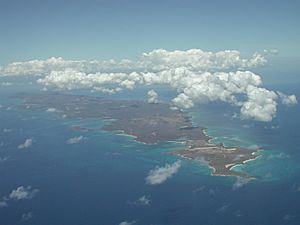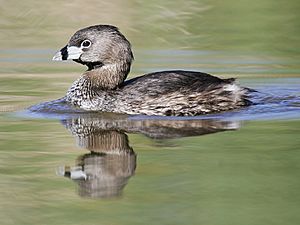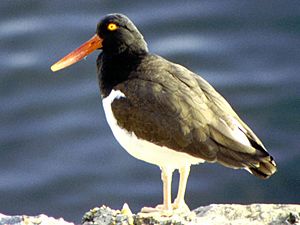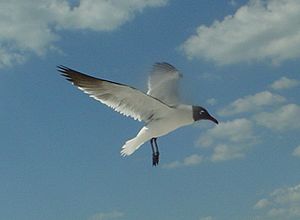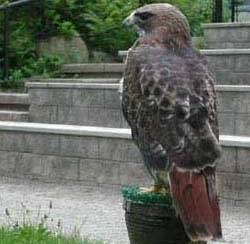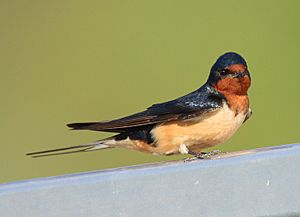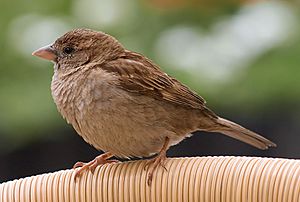List of birds of Vieques facts for kids
This is a list of all the different types of birds found on Vieques Island. Vieques is a special island that belongs to Puerto Rico. It's located just off the east coast of the main island, near Culebra and the Virgin Islands. Vieques is about 135 square kilometers of land, which is a pretty good size for birds to live! A big part of the island is a National Wildlife Refuge, which helps protect many animals, including birds. This refuge was created in two parts, in 2001 and 2003.
As of July 2022, there have been 196 different bird species seen on Vieques. Some birds, like the Puerto Rican parrot, used to live here but are now gone from the island. They are still included in this list to show they were once part of Vieques's bird family. This list will tell you the common name and the scientific name for each bird.
The birds are listed in a special order, like how scientists group them. This order comes from the "Check-list of North and Middle American Birds," which is made by the American Ornithological Society. The common names for bird families come from the Clements taxonomy.
Here are some special tags you'll see next to some bird names:
- (A) Accidental: This means the bird is usually not found here and only visits by chance.
- (I) Introduced: This means people brought the bird to the island, it's not naturally from here.
- (Ex) Extirpated: This means the bird used to live on Vieques but is now gone from the island.
Contents
- Ducks, Geese, and Waterfowl: Anatidae Family
- Guineafowl: Numididae Family
- New World Quail: Odontophoridae Family
- Flamingos: Phoenicopteridae Family
- Grebes: Podicipedidae Family
- Pigeons and Doves: Columbidae Family
- Cuckoos: Cuculidae Family
- Nightjars and Allies: Caprimulgidae Family
- Swifts: Apodidae Family
- Hummingbirds: Trochilidae Family
- Rails, Gallinules, and Coots: Rallidae Family
- Stilts and Avocets: Recurvirostridae Family
- Oystercatchers: Haematopodidae Family
- Lapwings and Plovers: Charadriidae Family
- Sandpipers and Allies: Scolopacidae Family
- Skuas and Jaegers: Stercorariidae Family
- Gulls, Terns, and Skimmers: Laridae Family
- Tropicbirds: Phaethontidae Family
- Shearwaters and Petrels: Procellariidae Family
- Storks: Ciconiidae Family
- Frigatebirds: Fregatidae Family
- Boobies and Gannets: Sulidae Family
- Cormorants and Shags: Phalacrocoracidae Family
- Pelicans: Pelecanidae Family
- Bitterns, Herons, and Egrets: Ardeidae Family
- Ibises and Spoonbills: Threskiornithidae Family
- New World Vultures: Cathartidae Family
- Osprey: Pandionidae Family
- Hawks, Eagles, and Kites: Accipitridae Family
- Owls: Strigidae Family
- Kingfishers: Alcedinidae Family
- Woodpeckers: Picidae Family
- Falcons and Caracaras: Falconidae Family
- New World and African Parrots: Psittacidae Family
- Tyrant Flycatchers: Tyrannidae Family
- Vireos, Shrike-babblers, and Erpornis: Vireonidae Family
- Swallows: Hirundinidae Family
- Starlings: Sturnidae Family
- Mockingbirds and Thrashers: Mimidae Family
- Thrushes and Allies: Turdidae Family
- Weavers and Allies: Ploceidae Family
- Waxbills and Allies: Estrildidae Family
- Whydahs: Viduidae Family
- Old World Sparrows: Passeridae Family
- Finches, Euphonias, and Allies: Fringillidae Family
- New World Sparrows: Passerellidae Family
- Spindalises: Spindalidae Family
- Troupials and Allies: Icteridae Family
- New World Warblers: Parulidae Family
- Cardinals and Allies: Cardinalidae Family
- Tanagers and Allies: Thraupidae Family
- See also
Ducks, Geese, and Waterfowl: Anatidae Family
Order: Anseriformes Family: Anatidae
This family includes ducks, geese, and swans. These birds are great at living in water. They have webbed feet for swimming and special bills for finding food in the water. Their feathers are also super good at shedding water, thanks to natural oils.
| Common name | Species | Status |
|---|---|---|
| West Indian whistling-duck | Dendrocygna arborea | |
| Canada goose | Branta canadensis | (A) |
| Blue-winged teal | Spatula discors | |
| Northern shoveler | Spatula clypeata | (A) |
| American wigeon | Mareca americana | (A) |
| White-cheeked pintail | Anas bahamensis | |
| Lesser scaup | Aythya affinis | (A) |
| Red-breasted merganser | Mergus serrator | (A) |
| Masked duck | Nomonyx dominicus | (A) |
| Ruddy duck | Oxyura jamaicensis |
Guineafowl: Numididae Family
Order: Galliformes Family: Numididae
Guineafowls are birds from Africa. They eat seeds and build their nests on the ground. They look a bit like partridges but have heads without feathers and gray, spotted feathers.
| Common name | Species | Status |
|---|---|---|
| Helmeted guineafowl | Numida meleagris | (I) |
New World Quail: Odontophoridae Family
Order: Galliformes Family: Odontophoridae
The New World quails are small, round birds that live on land. They are not closely related to the quails from other parts of the world, but they look and act similar.
| Common name | Species | Status |
|---|---|---|
| Northern bobwhite | Colinus virginianus | (Ex) |
Flamingos: Phoenicopteridae Family
Order: Phoenicopteriformes Family: Phoenicopteridae
Flamingos are tall, wading birds that live in groups. They can be 3 to 5 feet tall! Flamingos eat tiny shellfish and algae by filtering them from the water. Their beaks are specially shaped and used upside-down to help them find food.
| Common name | Species | Status |
|---|---|---|
| American flamingo | Phoenicopterus ruber | (A) |
Grebes: Podicipedidae Family
Order: Podicipediformes Family: Podicipedidae
Grebes are small to medium-sized birds that dive in freshwater. They have special lobed toes that make them excellent swimmers and divers. However, because their feet are set far back on their bodies, they are quite clumsy on land.
| Common name | Species | Status |
|---|---|---|
| Least grebe | Tachybaptus dominicus | |
| Pied-billed grebe | Podilymbus podiceps |
Pigeons and Doves: Columbidae Family
Order: Columbiformes Family: Columbidae
Pigeons and doves are birds with strong bodies, short necks, and thin bills. They have a soft, fleshy part at the base of their bill called a cere.
| Common name | Species | Status |
|---|---|---|
| Rock pigeon | Columba livia | (I) |
| Scaly-naped pigeon | Patagioenas squamosa | |
| White-crowned pigeon | Patagioenas leucocephala | |
| Eurasian collared-dove | Streptopelia decaocto | (I) |
| Common ground dove | Columbina passerina | |
| Ruddy quail-dove | Geotrygon montana | |
| Key West quail-dove | Geotrygon chrysia | |
| Bridled quail-dove | Geotrygon mystacea | |
| White-winged dove | Zenaida asiatica | |
| Zenaida dove | Zenaida aurita | |
| Mourning dove | Zenaida macroura |
Cuckoos: Cuculidae Family
Order: Cuculiformes Family: Cuculidae
The Cuculidae family includes cuckoos, roadrunners, and anis. These birds come in different sizes. They have slender bodies, long tails, and strong legs.
| Common name | Species | Status |
|---|---|---|
| Smooth-billed ani | Crotophaga ani | |
| Yellow-billed cuckoo | Coccyzus americanus | (A) |
| Mangrove cuckoo | Coccyzus minor | |
| Puerto Rican lizard-cuckoo | Saurothera vieilloti | (A) |
Nightjars and Allies: Caprimulgidae Family
Order: Caprimulgiformes Family: Caprimulgidae
Nightjars are medium-sized birds that are active at night. They usually make their nests on the ground. They have long wings, short legs, and very short bills. Their soft feathers are colored to blend in with tree bark or leaves, helping them hide.
| Common name | Species | Status |
|---|---|---|
| Antillean nighthawk | Chordeiles gundlachi | |
| Chuck-will's-widow | Antrostomus carolinensis | (A) |
Swifts: Apodidae Family
Order: Apodiformes Family: Apodidae
Swifts are small birds that spend most of their lives flying. They have very short legs and almost never land on the ground. Instead, they perch on vertical surfaces. Many swifts have long, swept-back wings that look like a crescent moon.
| Common name | Species | Status |
|---|---|---|
| White-collared swift | Streptoprocne zonaris | (A) |
| Chimney swift | Chaetura pelagica | (A) |
| Antillean palm swift | Tachornis phoenicobia | (A) |
Hummingbirds: Trochilidae Family
Order: Apodiformes Family: Trochilidae
Hummingbirds are tiny birds famous for hovering in the air. They flap their wings incredibly fast. They are the only birds that can fly backward!
| Common name | Species | Status |
|---|---|---|
| Puerto Rican mango | Anthracothorax aurulentus | (A) |
| Green-throated carib | Eulampis holosericeus | |
| Puerto Rican emerald | Riccordia maugaeus | |
| Antillean crested hummingbird | Orthorhyncus cristatus |
Rails, Gallinules, and Coots: Rallidae Family
Order: Gruiformes Family: Rallidae
This family includes rails, crakes, coots, and gallinules. These birds are usually found in thick plants near lakes, swamps, or rivers. They are often shy and hard to spot. Most have strong legs and long toes, which help them walk on soft, uneven ground.
| Common name | Species | Status |
|---|---|---|
| Clapper rail | Rallus crepitans | |
| Sora | Porzana carolina | (A) |
| Common gallinule | Gallinula galeata | |
| American coot | Fulica americana | |
| Black rail | Laterallus jamaicensis | (A) |
Stilts and Avocets: Recurvirostridae Family
Order: Charadriiformes Family: Recurvirostridae
This family includes avocets and stilts. They are large wading birds. Avocets have long legs and bills that curve upward. Stilts have extremely long legs and long, thin, straight bills.
| Common name | Species | Status |
|---|---|---|
| Black-necked stilt | Himantopus mexicanus |
Oystercatchers: Haematopodidae Family
Order: Charadriiformes Family: Haematopodidae
Oystercatchers are large, easy-to-spot, and noisy birds. They have strong bills that they use to break open or pry apart molluscs.
| Common name | Species | Status |
|---|---|---|
| American oystercatcher | Haematopus palliatus |
Lapwings and Plovers: Charadriidae Family
Order: Charadriiformes Family: Charadriidae
This family includes plovers, dotterels, and lapwings. They are small to medium-sized birds with compact bodies, short, thick necks, and long, pointed wings. You can find them in open areas around the world, especially near water.
| Common name | Species | Status |
|---|---|---|
| Black-bellied plover | Squatarola squatarola | |
| American golden-plover | Pluvialis dominica | (A) |
| Wilson's plover | Charadrius wilsonia | |
| Semipalmated plover | Charadrius semipulmatus | |
| Piping plover | Charadrius melodus | (A) |
| Killdeer | Charadrius vociferus |
Sandpipers and Allies: Scolopacidae Family
Order: Charadriiformes Family: Scolopacidae
Scolopacidae is a large family of shorebirds. It includes sandpipers, curlews, godwits, and many others. Most of these birds eat small bugs they find in mud or soil. Different bill and leg lengths allow many species to feed in the same places without fighting for food.
| Common name | Species | Status |
|---|---|---|
| Whimbrel | Numenius phaeopus | (A) |
| Hudsonian godwit | Limosa haemastica | (A) |
| Ruddy turnstone | Arenaria interpres | |
| Red knot | Calidris canutus | (A) |
| Stilt sandpiper | Calidris himantopus | |
| Sanderling | Calidris alba | |
| Least sandpiper | Calidris minutilla | |
| White-rumped sandpiper | Calidris fuscicollis | (A) |
| Pectoral sandpiper | Calidris melanotos | (A) |
| Semipalmated sandpiper | Calidris pusilla | (A) |
| Western sandpiper | Calidris mauri | |
| Short-billed dowitcher | Limnodromus griseus | |
| Wilson's snipe | Gallinago delicata | (A) |
| Spotted sandpiper | Actitis macularius | |
| Solitary sandpiper | Tringa solitaria | (A) |
| Greater yellowlegs | Tringa melanoleuca | |
| Willet | Tringa semipalmata | (A) |
| Lesser yellowlegs | Tringa flavipes |
Skuas and Jaegers: Stercorariidae Family
Order: Charadriiformes Family: Stercorariidae
These are medium to large birds, usually gray or brown, with white marks on their wings. They nest on the ground in cooler parts of the world and fly long distances when they migrate.
| Common name | Species | Status |
|---|---|---|
| Parasitic jaeger | Stercorarius parasiticus | (A) |
Gulls, Terns, and Skimmers: Laridae Family
Order: Charadriiformes Family: Laridae
Laridae is a family of medium to large seabirds. It includes gulls, kittiwakes, terns, and skimmers. They are usually gray or white, often with black on their heads or wings. They have longish bills and webbed feet. Terns are known for diving to catch fish. Many terns live for a long time, often more than 25-30 years.
| Common name | Species | Status |
|---|---|---|
| Laughing gull | Leucophaeus atricilla | |
| Herring gull | Larus argentatus | |
| Lesser black-backed gull | Larus fuscus | (A) |
| Brown noddy | Anous stolidus | |
| Sooty tern | Onychoprion fuscatus | |
| Bridled tern | Onychoprion anaethetus | |
| Least tern | Sternula antillarum | |
| Gull-billed tern | Gelochelidon nilotica | (A) |
| Caspian tern | Hydroprogne caspia | (A) |
| Roseate tern | Sterna dougallii | |
| Common tern | Sterna hirundo | |
| Forster's tern | Sterna forsteri | (A) |
| Royal tern | Thalasseus maximus | |
| Sandwich tern | Thalasseus sandvicensis | (A) |
| Black skimmer | Rynchops niger | (A) |
Tropicbirds: Phaethontidae Family
Order: Phaethontiformes Family: Phaethontidae
Tropicbirds are thin, white birds that live in tropical oceans. They have very long feathers in the middle of their tails. Their long wings and heads have black markings.
| Common name | Species | Status |
|---|---|---|
| White-tailed tropicbird | Phaethon lepturus | |
| Red-billed tropicbird | Phaethon aethereus |
Shearwaters and Petrels: Procellariidae Family
Order: Procellariiformes Family: Procellariidae
The Procellariids are a main group of medium-sized "true petrels." They have nostrils that are joined together and a long, working outer primary feather.
| Common name | Species | Status |
|---|---|---|
| Cory's shearwater | Calonectris diomedea | (A) |
Storks: Ciconiidae Family
Order: Ciconiiformes Family: Ciconiidae
Storks are large, heavy wading birds with long legs, long necks, and strong bills. They have wide wingspans. Unlike some other wading birds, storks do not have special powder to clean fish slime from their feathers. Storks also cannot make sounds because they lack a voice box.
| Common name | Species | Status |
|---|---|---|
| Wood stork | Mycteria americana | (A) |
Frigatebirds: Fregatidae Family
Order: Suliformes Family: Fregatidae
Frigatebirds are large seabirds found over tropical oceans. They are mostly black or black and white, with long wings and deeply forked tails. Male frigatebirds have colorful throat pouches that they can inflate. They cannot swim or walk well and cannot take off from flat ground. They have the largest wingspan for their body weight of any bird, allowing them to stay in the air for over a week!
| Common name | Species | Status |
|---|---|---|
| Magnificent frigatebird | Fregata magnificens |
Boobies and Gannets: Sulidae Family
Order: Suliformes Family: Sulidae
The Sulids include gannets and boobies. Only boobies are found in Vieques. Both are medium-large coastal seabirds that dive headfirst into the water to catch fish.
| Common name | Species | Status |
|---|---|---|
| Masked booby | Sula dactylatra | |
| Brown booby | Sula leucogaster |
Cormorants and Shags: Phalacrocoracidae Family
Order: Suliformes Family: Phalacrocoracidae
This family includes cormorants and shags. They are medium to large seabirds that eat fish. Most have dark feathers, some are black and white, and a few are quite colorful.
| Common name | Species | Status |
|---|---|---|
| Double-crested cormorant | Nannopterum auritum | (A) |
Pelicans: Pelecanidae Family
Order: Pelecaniformes Family: Pelecanidae
Pelicans are very large water birds. They have a special pouch under their beak for catching fish. Like other birds in their group, they have four webbed toes.
| Common name | Species | Status |
|---|---|---|
| American white pelican | Pelecanus erythrorhynchos | (A) |
| Brown pelican | Pelecanus occidentalis |
Bitterns, Herons, and Egrets: Ardeidae Family
Order: Pelecaniformes Family: Ardeidae
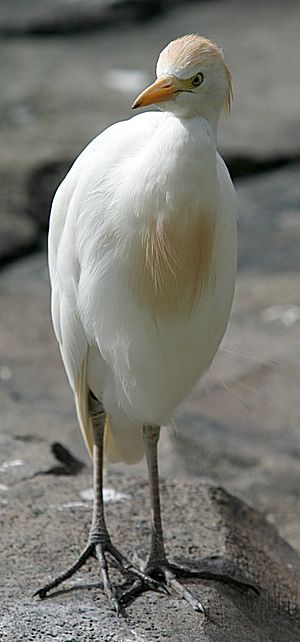
The Ardeidae family includes bitterns, herons, and egrets. Herons and egrets are medium to large wading birds with long necks and legs. Bitterns are usually shorter-necked and harder to spot. When they fly, these birds pull their necks back, which is different from other long-necked birds like storks.
| Common name | Species | Status |
|---|---|---|
| Least bittern | Ixobrychus exilis | |
| Great blue heron | Ardea herodias | |
| Great egret | Egretta alba | |
| Snowy egret | Egretta thula | |
| Little blue heron | Egretta caerulea | |
| Tricolored heron | Egretta tricolor | |
| Reddish egret | Egretta rufescens | (A) |
| Cattle egret | Bubulcus ibis | |
| Green heron | Butorides virescens | |
| Black-crowned night heron | Nycticorax nycticorax | |
| Yellow-crowned night heron | Nyctanassa violacea |
Ibises and Spoonbills: Threskiornithidae Family
Order: Pelecaniformes Family: Threskiornithidae
Threskiornithidae is a family of large birds that live on land and in water. It includes ibises and spoonbills. They have long, wide wings and are strong flyers. Surprisingly, for their size, they are also very good at soaring high in the sky.
| Common name | Species | Status |
|---|---|---|
| Scarlet ibis | Eudocimus ruber | (A) |
| Glossy ibis | Plegadis falcinellus | (A) |
New World Vultures: Cathartidae Family
Order: Cathartiformes Family: Cathartidae
The New World vultures look like vultures from other parts of the world, but they are not closely related. They both eat dead animals. However, New World vultures have a great sense of smell to find food, while Old World vultures rely on sight.
| Common name | Species | Status |
|---|---|---|
| Turkey vulture | Cathartes aura | (I) |
Osprey: Pandionidae Family
Order: Accipitriformes Family: Pandionidae
The Pandionidae family has only one species: the osprey. The osprey (Pandion haliaetus) is a medium-large raptor. It specializes in eating fish and can be found all over the world.
| Common name | Species | Status |
|---|---|---|
| Osprey | Pandion haliaetus |
Hawks, Eagles, and Kites: Accipitridae Family
Order: Accipitriformes Family: Accipitridae
Accipitridae is a family of birds of prey. It includes hawks, eagles, kites, and harriers. These birds have very strong, hooked beaks for tearing meat from their prey. They also have strong legs, powerful talons, and excellent eyesight.
| Common name | Species | Status |
|---|---|---|
| Swallow-tailed kite | Elanoides forficatus | (A) |
| Northern harrier | Circus hudsonius | (A) |
| Broad-winged hawk | Buteo platypterus | |
| Red-tailed hawk | Buteo jamaicensis |
Owls: Strigidae Family
Order: Strigiformes Family: Strigidae
The typical owls are small to large birds of prey that hunt alone at night. They have big eyes that face forward and large ears. They also have a beak like a hawk and a circle of feathers around each eye called a facial disk.
| Common name | Species | Status |
|---|---|---|
| Short-eared owl | Asio flammeus |
Kingfishers: Alcedinidae Family
Order: Coraciiformes Family: Alcedinidae
Kingfishers are medium-sized birds. They have large heads, long, pointed bills, short legs, and stubby tails.
| Common name | Species | Status |
|---|---|---|
| Belted kingfisher | Megaceryle alcyon |
Woodpeckers: Picidae Family
Order: Piciformes Family: Picidae
Woodpeckers are small to medium-sized birds. They have chisel-like beaks, short legs, stiff tails, and long tongues for catching insects. Many woodpeckers tap loudly on tree trunks with their beaks.
| Common name | Species | Status |
|---|---|---|
| Yellow-bellied sapsucker | Sphyrapicus varius | (A) |
| Puerto Rican woodpecker | Melanerpes portoricensis |
Falcons and Caracaras: Falconidae Family
Order: Falconiformes Family: Falconidae
Falconidae is a family of birds of prey that are active during the day. They are different from hawks and eagles because they kill their prey with their beaks, not their talons.
| Common name | Species | Status |
|---|---|---|
| American kestrel | Falco sparverius | |
| Merlin | Falco columbarius | (A) |
| Peregrine falcon | Falco peregrinus | (A) |
New World and African Parrots: Psittacidae Family
Order: Psittaciformes Family: Psittacidae
Parrots are birds that can be small to large. They have a special curved beak. Their upper beak can move a little where it connects to their skull. All parrots have two toes pointing forward and two pointing backward on each foot.
| Common name | Species | Status |
|---|---|---|
| Monk parakeet | Myiopsitta monachus | (I) |
| Puerto Rican parrot | Amazona vittata | (Ex) |
| Brown-throated parakeet | Eupsittula pertinax | (Ex) |
Tyrant Flycatchers: Tyrannidae Family
Order: Passeriformes Family: Tyrannidae
Tyrant flycatchers are songbirds found in North and South America. They look a bit like flycatchers from other parts of the world, but they are stronger and have tougher bills. Most of them eat insects.
| Common name | Species | Status |
|---|---|---|
| Caribbean elaenia | Elaenia martinica | |
| Puerto Rican flycatcher | Miarchus antillarum | |
| Gray kingbird | Tyrannus dominicensis | |
| Loggerhead kingbird | Tyrannus caudifasciatus | |
| Scissor-tailed flycatcher | Tyrannus caudifasciatus | (A) |
| Fork-tailed flycatcher | Tyrannus caudifasciatus | (A) |
Vireos, Shrike-babblers, and Erpornis: Vireonidae Family
Order: Passeriformes Family: Vireonidae
The vireos are small to medium-sized songbirds. They are usually greenish and look like wood warblers, but they have stronger bills.
| Common name | Species | Status |
|---|---|---|
| White-eyed vireo | Vireo griseus | (A) |
| Yellow-throated vireo | Vireo flavifrons | (A) |
| Red-eyed vireo | Vireo olivaceus | |
| Black-whiskered vireo | Vireo altiloquus |
Swallows: Hirundinidae Family
Order: Passeriformes Family: Hirundinidae
The Hirundinidae family is made up of birds that are built for catching food while flying. They have slender bodies, long pointed wings, and short bills with wide mouths. Their feet are made for perching, not walking.
| Common name | Species | Status |
|---|---|---|
| Northern rough-winged swallow | Stelgidopteryx serripennis | (A) |
| Caribbean martin | Progne dominicensis | |
| Bank swallow | Riparia riparia | (A) |
| Barn swallow | Hirundo rustica | |
| Cliff swallow | Petrochelidon pyrrhonota | (A) |
| Cave swallow | Petrochelidon fulva |
Starlings: Sturnidae Family
Order: Passeriformes Family: Sturnidae
Starlings are small to medium-sized songbirds with strong feet. They fly strongly and directly and often live in large groups. They prefer open areas and eat insects and fruit. Their feathers are usually dark with a shiny, metallic look.
| Common name | Species | Status |
|---|---|---|
| European starling | Sturnus vulgaris | (A) |
Mockingbirds and Thrashers: Mimidae Family
Order: Passeriformes Family: Mimidae
The Mimids are a family of songbirds that includes thrashers, mockingbirds, and New World catbirds. These birds are famous for their amazing singing. They can copy many different bird calls and other sounds they hear outside. They usually have dull gray and brown feathers.
| Common name | Status | |
|---|---|---|
| Gray catbird | Dumetella carolinensis | (A) |
| Pearly-eyed thrasher | Margarops fuscatus | |
| Northern mockingbird | Mimus polyglottos |
Thrushes and Allies: Turdidae Family
Order: Passeriformes Family: Turdidae
The thrushes are a group of songbirds. They are plump, with soft feathers, and are small to medium-sized. They eat insects or sometimes everything (omnivores), often finding food on the ground. Many thrushes have beautiful songs.
| Common name | Status | |
|---|---|---|
| Bicknell's thrush | Catharus bicknelli | (A) |
| Red-legged thrush | Turdus plumbeus | (A) |
Weavers and Allies: Ploceidae Family
Order: Passeriformes Family: Ploceidae
Weavers are small songbirds related to finches. They eat seeds and have rounded, cone-shaped bills. Many species are known for building large, woven nests, which is how they got their name. They are social birds and often nest together in groups.
| Common name | Status | |
|---|---|---|
| Northern red bishop | Euplectes franciscanus | (A) |
Waxbills and Allies: Estrildidae Family
Order: Passeriformes Family: Estrildidae
The estrildid finches are small songbirds from tropical areas of the Old World and Australia. They are social birds that eat seeds and have short, thick, but pointed bills. They all have similar body shapes and habits, but their feather colors and patterns can be very different.
| Common name | Species | Status | |
|---|---|---|---|
| Bronze mannikin | Spermestes cucullata | (I) | |
| Scaly-breasted munia | Lonchura punctulata | (I) |
Whydahs: Viduidae Family
Order: Passeriformes Family: Viduidae
The Viduidae is a family of small songbirds from Africa. It includes indigobirds and whydahs. All species in this family are "brood parasites." This means they lay their eggs in the nests of other birds, usually estrildid finches, and let those birds raise their young. These birds usually have black or dark blue feathers.
| Common name | Species | Status |
|---|---|---|
| Pin-tailed whydah | Vidua macroura | (I) |
Old World Sparrows: Passeridae Family
Order: Passeriformes Family: Passeridae
Sparrows are small songbirds. They are generally plump, brownish or grayish birds with short tails and strong, short beaks. Sparrows mainly eat seeds, but they also eat small insects.
| Common name | Species | Status |
|---|---|---|
| House sparrow | Passer domesticus | (I) |
Finches, Euphonias, and Allies: Fringillidae Family
Order: Passeriformes Family: Fringillidae
Finches are songbirds that eat seeds. They are small to medium-sized and have strong beaks, usually shaped like a cone. These birds fly with a bouncing motion, flapping their wings and then gliding. Most finches sing well.
| Common name | Species | Status |
|---|---|---|
| Puerto Rican euphonia | Chlorophonia sclateri | (Ex) |
New World Sparrows: Passerellidae Family
Order: Passeriformes Family: Passerellidae
New World sparrows are birds that eat seeds and have uniquely shaped bills. Most birds in this family are called sparrows, but they are not closely related to the Old World sparrows. Many species have special patterns on their heads.
| Common name | Species | Status |
|---|---|---|
| Grasshopper sparrow | Ammodramus savannarum |
Spindalises: Spindalidae Family
Order: Passeriformes Family: Spindalidae
The birds in this small family live in the Greater Antilles. They used to be grouped with tanagers but were given their own family in 2017.
| Common name | Species | Status |
|---|---|---|
| Puerto Rican spindalis | Spindalis portoricensis | (A) |
Troupials and Allies: Icteridae Family
Order: Passeriformes Family: Icteridae
The icterids are a group of small to medium-sized songbirds found only in the New World. They are often colorful and include grackles, New World blackbirds, and New World orioles. Most species have black as their main feather color, often brightened with yellow, orange, or red.
| Common name | Species | Status |
|---|---|---|
| Bobolink | Dolichonyx oryzivorus | (A) |
| Baltimore oriole | Icterus galbula | (A) |
| Yellow-shouldered blackbird | Agelaius xanthomus | (A) |
| Shiny cowbird | Molothrus bonariensis | |
| Brown-headed cowbird | Molothrus ater | (A) |
| Greater Antillean grackle | Quiscalus niger |
New World Warblers: Parulidae Family
Order: Passeriformes Family: Parulidae
The New World warblers are a group of small, often colorful songbirds found only in the New World. Most live in trees, but some spend more time on the ground. Most birds in this family eat insects.
| Common name | Species | Status |
|---|---|---|
| Ovenbird | Seiurus aurocapilla | |
| Worm-eating warbler | Helmitheros vermivorum | (A) |
| Louisiana waterthrush | Parkesia motacilla | (A) |
| Northern waterthrush | Parkesia novaboracensis | |
| Black-and-white warbler | Mniotilta varia | |
| Prothonotary warbler | Protonotaria citrea | (A) |
| Tennessee warbler | Leiothlypis peregrina | (A) |
| Connecticut warbler | Oporornis agilis | (A) |
| Mourning warbler | Geothlypis philadelphia | (A) |
| Kentucky warbler | Geothlypis formosa | (A) |
| Common yellowthroat | Geothlypis trichas | |
| Hooded warbler | Setophaga citrina | (A) |
| American redstart | Setophaga ruticilla | |
| Cape May warbler | Setophaga tigrina | |
| Northern parula | Setophaga americana | |
| Magnolia warbler | Setophaga magnolia | (A) |
| Blackburnian warbler | Setophaga fusca | (A) |
| Yellow warbler | Setophaga petechia | |
| Blackpoll warbler | Setophaga striata | |
| Black-throated blue warbler | Setophaga caerulescens | (A) |
| Palm warbler | Setophaga palmarum | (A) |
| Pine warbler | Setophaga pinus | (A) |
| Yellow-rumped warbler | Setophaga coronata | (A) |
| Yellow-throated warbler | Setophaga dominica | (A) |
| Prairie warbler | Setophaga discolor | |
| Adelaide's warbler | Setophaga adelaidae | |
| Black-throated green warbler | Setophaga virens | (A) |
| Canada warbler | Cardellina canadensis | (A) |
Cardinals and Allies: Cardinalidae Family
Order: Passeriformes Family: Cardinalidae
The cardinals are a family of strong, seed-eating birds with powerful bills. They usually live in open woodlands. Males and females often have different feather colors.
| Common name | Species | Status |
|---|---|---|
| Scarlet tanager | Piranga olivacea | (A) |
| Rose-breasted grosbeak | Pheucticus ludovicianus | (A) |
| Indigo bunting | Passerina cyanea | (A) |
Tanagers and Allies: Thraupidae Family
Order: Passeriformes Family: Thraupidae
The bananaquit is a small songbird. It has a slender, curved bill that helps it drink nectar from flowers. It is the only member of its genus and is usually placed in the Thraupidae family.
| Common name | Species | Status |
|---|---|---|
| Bananaquit | Coereba flaveola | |
| Yellow-faced grassquit | Tiaris olivaceus | |
| Lesser Antillean bullfinch | Loxigilla noctis | (A) |
| Black-faced grassquit | Melanospiza bicolor |
See also
- List of birds
- Lists of birds by region
- List of endemic fauna of Puerto Rico
- List of birds of Puerto Rico


